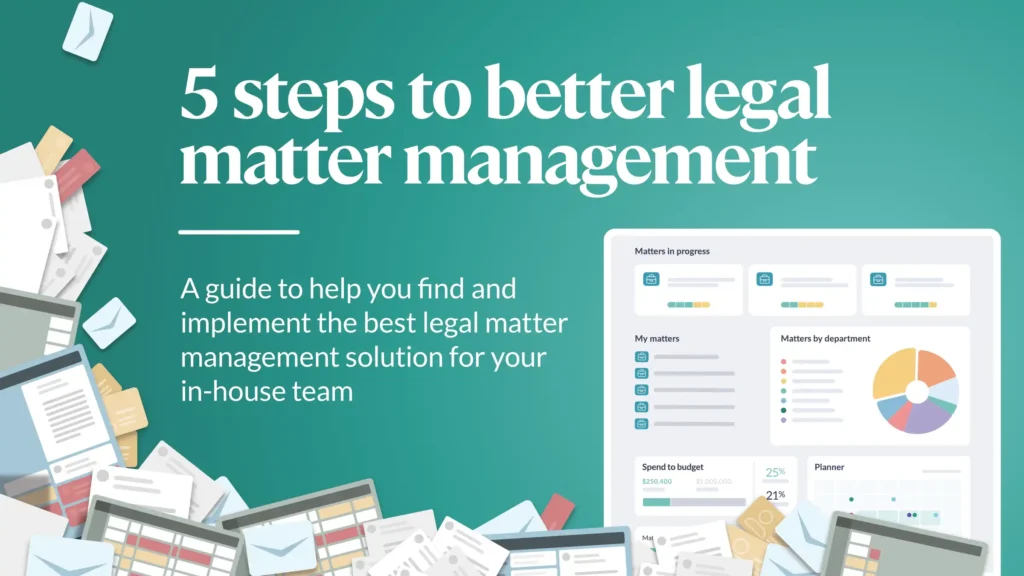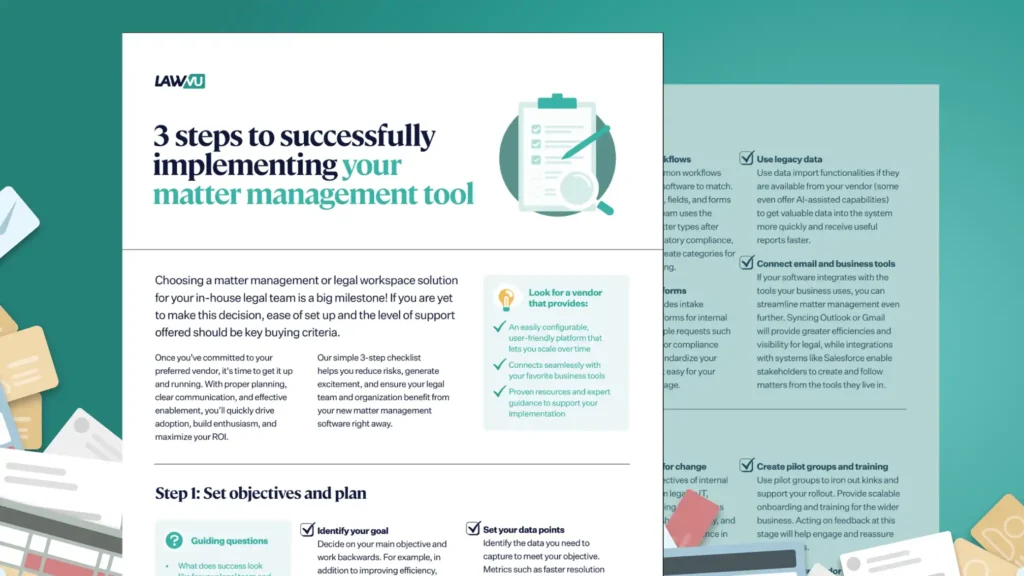Implementing matter management software for in-house teams: 3 steps to success

Choosing the right solution for managing your in-house legal matters is a big milestone — and once you’ve committed to your preferred vendor, it’s time to get it up and running. Our checklist ensures you set your new matter management software and organization up for long-term success.
Effective implementation is a critical step in your legal tech journey. Here’s why:
- Delivers tangible value, faster: A good implementation returns value quickly. This not only solves your most pressing problems, it reinforces your decision to invest and motivates the business to continue
- Removes obstacles: Allows you to mitigate issues, deliver a seamless experience, and to progress with less dependence on IT teams or decision-makers who might slow things down
- Facilitates positive adoption: A great first experience helps your team quickly benefit from your new tool, while a poor one could mean you struggle to get the buy-in and engagement you need
Know this: when the gap between “what it takes from your team and vendor” and “what is given” is too large, your exciting transformation can become a rescue mission! From securing buy-in across the business, to ensuring that you reap the maximum value of your new software for years to come, successful implementation requires a strategic approach.
Understanding the importance of legal matters for in-house counsel and your team’s greatest matter management needs is the first place to start. If you’ve chosen a vendor that provides a flexible, user-friendly setup with expert guidance and support [like LawVu!] you’re already in a great position to achieve a smooth transition. But there’s work to be done on your end too — so follow our 3-step checklist to mitigate risks, build excitement, and ensure your legal team and organization can reap the benefits of your new matter management software from the get go.
“Having a strong partner relationship with a vendor is just as important as good software – and we have both with LawVu.”
Andrew Hay – Head of Operations, Legal & Secretariat – Co-op
How to ensure a positive, impactful experience for everyone
There are three overarching steps that lead to a successful software implementation:
- Set objectives and plan
- Configure your setup
- Build engagement
As a companion to LawVu’s complete guide to better legal matter management, this article breaks each implementation step into 3 simple checklists with guiding questions and recommendations.
Step 1: Set objectives and create a plan
It’s crucial to outline your goals and objectives, then create a plan to execute your strategy. Equally important is strong sponsorship and advocacy, helping to motivate and align stakeholders across your organization.
A respected, visible project sponsor underpins your success. Identify your sponsor early and ensure they endorse your tool and processes across communication channels and meetings. Department champions can further reinforce the message and support requests from your legal team.
“Effective project sponsors don’t simply manage timelines and budgets; they need to actively champion change, foster trust, and communicate almost relentlessly how the initiative is going to deliver real value. If you don’t, then unfortunately, there is a real risk your initiative becomes another “tried but failed” statistic”
Shaun Plant, author of How to make in-house a powerhouse
Now is also the time to define roles like project lead, subject matter experts, and IT contacts. Establishing these early ensures efficient decisions, smooth task completion, and buy-in for your new matter management tool. Proper alignment will secure the visibility and priority needed across your organization.
Early adopters, advocates, and peer training play a vital role in uniting the team and driving success, but some resistance is inevitable. Addressing concerns quickly is crucial. It helps to involve these individuals by assigning them meaningful roles in the project to reduce disruption and turn resistance into engagement.
Finally, determine how you’ll gather feedback and measure success. Stakeholder input is key to shaping the platform, ensuring readiness, and driving progress. Clear data and sentiment metrics will help you track progress, optimize, and report back to the business. Feedback will also help you celebrate milestones and keep things moving.
Thoughtful preparation and clear, positive communication will position your new software as a credible, high-priority initiative and set the foundation for a smooth implementation and measurable impact.
Planning checklist
Guiding questions:
- What does success look like for your legal team and organization?
- How will you measure success, collect feedback and data?
- Who are your stakeholders and who can help advocate for this new tool?
√ Identify your goal
Decide on your main objective and work backwards. For example, in addition to improving efficiency, you might want to highlight legal’s value and justify future budget or headcount increases.
√ Create your project team
Name the key people who will contribute to your project’s success, the role they will play and their responsibilities. This is a great time to identify your key stakeholders, sponsors, and champions too.
√ Set your data points
Identify the data you need to capture to meet your objective. Metrics such as faster resolution times, risk levels, complexity of matters, or spend versus budget can help demonstrate value.
√ Seek feedback
Discovery workshops with your legal team, stakeholders and implementation experts can uncover pain points, workflows, and future needs, making sure to cross reference the results against business priorities.
Step 2: Configure for your needs
If you’ve chosen an easily configurable matter management solution, you’ll be able to apply key customizations and set the system up to make core workflows more efficient right away. Your vendor should be able to help you identify best practice, and also guide you toward the features that best serve your needs.
Map out your current workflows for intake and matter management, as well as how stakeholders create and receive updates on their requests. Think about where your matters originate — what departments, and are they using email or tools like Salesforce or Microsoft Teams to make requests? What notifications or reports do they need? Avoid overwhelming your team by trying to do everything at once. Identify features in your new tool that offer the greatest value and efficiency. Quick wins, like streamlining repetitive workflows, improving collaboration with priority stakeholders, and cutting admin tasks, are a great place to start!
We recommend starting with the capability you need most, then adding workflows and utilizing more features as you learn and scale. This ensures your new matter management tool is set up to quickly address your real needs, and integrates seamlessly with everyone’s daily work.
Configuration checklist
Guiding questions:
- Where are your matter requests coming from? What types, complexity, volume?
- How do you want to use the tool to record, structure, and track matters?
- What information does legal need to get started on a matter request?
√ Configure key workflows
Start with your common workflows and configure your software to match. Set up matter types, fields, and forms to guide how your team uses the platform. Name matter types after your work (eg, regulatory compliance, IP, contracts) and create categories for tracking and reporting.
√ Customize intake forms
If your solution includes intake capabilities, create forms for internal users to submit simple requests such as contract reviews or compliance checks. This will standardize your process and make it easy for your stakeholders to engage.
√ Use legacy data
Use data import functionalities if they are available from your vendor (some even offer AI-assisted capabilities) to get valuable data into the system more quickly and receive useful reports faster.
√ Connect email and business tools
If your software integrates with the tools your business uses, you can streamline matter management even further. Syncing Outlook or Gmail will provide greater efficiencies and visibility for legal, while integrations with systems like Salesforce enable stakeholders to create and follow matters from the tools they live in.
Step 3: Build engagement
The goal is for your organization to embrace this new way of working with legal. This is where sponsors, champions, and subject matter experts must shine. Clear communication, repetition, and a balance of firmness and empathy are key. Consider your organization’s culture and rituals. Share your project in the right forums and in ways that resonate. Celebrate milestones, wins, and insights early!
Engagement checklist
Guiding questions:
- Who are my stakeholders and how will I collect feedback and interact with them?
- What are my sponsor and champions’ strengths and how can I leverage them?
- What resources, advice, and support can my vendor offer during implementation and beyond?
√ Assess readiness for change
Consider the perspectives of internal stakeholders — from legal to IT, finance, and marketing — to assess change readiness, show empathy, and build engagement and confidence in the process.
√ Codesign your rollout
Without strong sponsorship, any implementation program will fail. A sponsor who understands the benefits and can influence stakeholders is essential. Work with them to create a rollout plan that resonates with each department.
√ Create pilot groups and training
Use pilot groups to iron out kinks and support your rollout. Provide scalable onboarding and training for the wider business. Acting on feedback at this stage will help engage and reassure stakeholders.
√ Lean on your vendor
Take advantage of the implementation support offered by your vendor — from customer success management programs and personalized training, to learning resources like the Masters of Change course in the LawVu Academy. Ask about best practice based on similar customers too.
Tip: Check out the Change management and adoption section in LawVu’s complete guide to better matter management for further change management best practices.
Ready to take the next step?
A strategic approach to implementing in-house matter management software is essential to gaining buy-in and ensuring success. Choosing the right tool and partnering with a supportive vendor will help you achieve your goals. Start with a clear implementation plan, take small, manageable steps, and prioritize business engagement to deliver great service and meet your objectives.
If you’re looking for an intuitive solution with expert support, LawVu can help. Check out LawVu’s complete guide to better legal matter management, then book a demo to see matter management in action and learn how our proven approach to onboarding ensures results in weeks, not months.


